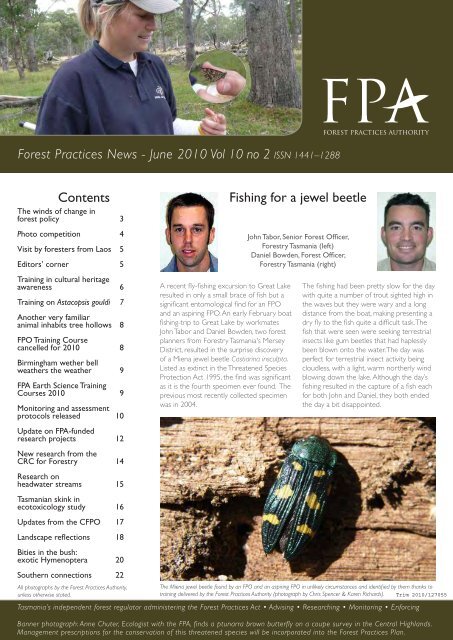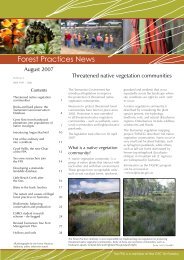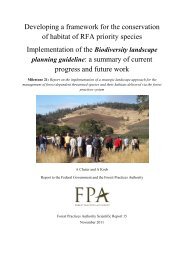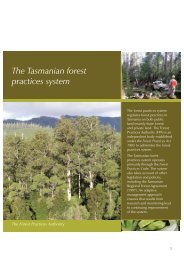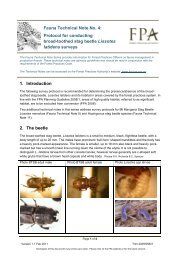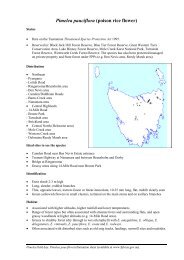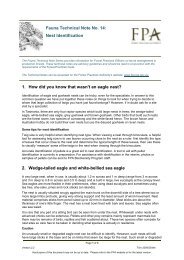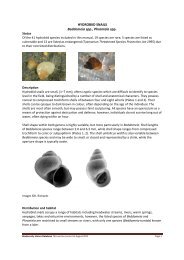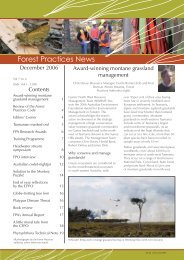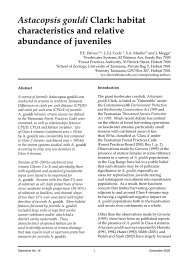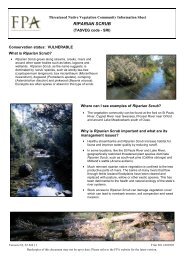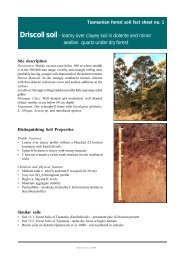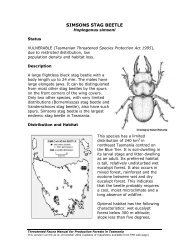FPN vol 10 no 2 June 2010 - The Forest Practices Authority
FPN vol 10 no 2 June 2010 - The Forest Practices Authority
FPN vol 10 no 2 June 2010 - The Forest Practices Authority
Create successful ePaper yourself
Turn your PDF publications into a flip-book with our unique Google optimized e-Paper software.
<strong>The</strong> winds of change in forest policy –the opportunities for the future (continued)to adequately manage other values such asbiodiversity and water, thus fuelling genuineconcerns about the overall sustainability offorest practices. In addition, whilst the areaof forest in reserves has increased (by 49%since 1996) this has been accompaniedby a significant reduction in the total areaof native forest (of almost 5%), primarilythrough conversion to more intensivelymanaged plantations.<strong>The</strong> current forest policy debate isunfortunately distorted by misinformationand entrenched myths, including-1. <strong>The</strong> myth that logging destroys forests.<strong>The</strong> reality is that most of our forestsare ecologically tuned to respond tonatural disturbance regimes such aswildfire. Logging is different, but at theright scale and intensity it can closelyemulate natural ecological processes.2. <strong>The</strong> myth that forests can simply be‘reserved’ and maintained in goodecological condition without unduecost on the public or private owner.<strong>The</strong> reality is that most forests,especially those accessible to people,need some form of active managementto maintain infrastructure and assetsand to control pests, weeds, wildfireand illegal activities.3. <strong>The</strong> myth that all conservation valuescan be adequately captured in reservesand that forests outside reserves canbe used for resource extraction orother eco<strong>no</strong>mic activities withoutundue constraint. <strong>The</strong> reality is thatTasmania’s forest estate is fragmentedwithin a mosaic of land uses. Species,especially those that require largeranges for foraging and breeding, do<strong>no</strong>t respect tenure boundaries. Allforests, woodlands and scatteredtrees in paddocks contain potentiallysignificant habitat for threatened andother species. <strong>The</strong>se areas do <strong>no</strong>tnecessarily need to be ‘reserved’ butthey need to have practical measuresapplied in order to conserve importanthabitat attributes such as trees withhollows.After years of trench warfare on forestpolicy in Tasmania we <strong>no</strong>w find ourselveswith an unprecedented policy crisis. It’s <strong>no</strong>tthe fault of the international markets, theAustralian dollar, corporate greed or greenactivists. It’s our collective fault to respondmore proactively to the signals for change.<strong>Practices</strong> such as large-scale clearfelling ofnative forests, poisoning wildlife and releasinglarge quantities of smoke into populatedareas were accepted by the community inthe past. <strong>The</strong>y are <strong>no</strong> longer accepted. <strong>The</strong>public good will <strong>no</strong>t be served by a<strong>no</strong>thertrade-off that simply sees further forestsbeing placed in reserves and a continuatio<strong>no</strong>r intensification of current woodproductionpractices in remaining forests.Nor will the public good be served by adecision to end sustainable resource usefrom native forests simply because it’s all toosocially and politically difficult. <strong>The</strong> publicgood is best served by a comprehensiveanalysis of the options for a sustainablefuture for our forests and forest industries.This will take time. It will require meaningfulengagement with all stakeholders, includingland managers scientists, practitioners andregulators, and a willingness by the parties toset aside the paradigms of the past. <strong>The</strong> firstcritical task should be to develop an agreeddefinition of ‘sustainable forest management’.<strong>The</strong> second task should be to agree on thespecific objectives and outcomes for theenvironmental, eco<strong>no</strong>mic and social servicesthat we wish the forest estate to provideinto the future.Without such objectives and measurableoutcomes there can be <strong>no</strong> way of everanswering the most important question ofall: ‘Are Tasmania’s forests being managed ona sustainable basis?’Author’s contact:Graham.Wilkinson@fpa.tas.gov.auNative forests can be sustainably managed to provide a range of environmental, eco<strong>no</strong>mic and social services, includingnature conservation, wood production, watershed protection and grazing. Effective policy and management practices arenecessary to maintain both reserved and <strong>no</strong>n-reserved forests in good ecological condition.<strong>June</strong> 20<strong>10</strong> <strong>Forest</strong> <strong>Practices</strong> News <strong>vol</strong> <strong>10</strong> <strong>no</strong> 23
You never stop learning! Tim Leaman and Dydee Mann from the FPA searching for the a rare herb Stellaria multiflora in a coupe adjacent to Den Hill <strong>Forest</strong> Reserve, Bothwell, in Aprilthis year. In this case the rare plant was found outside the coupe and it was concluded that harvest posed <strong>no</strong> threat to the species. Thanks to Planning FPO Jason Bolch for sending inthis photograph.Freeentry!<strong>Forest</strong> <strong>Practices</strong> News photo competitionExtendedto August20<strong>10</strong>!<strong>The</strong> first ever <strong>Forest</strong> <strong>Practices</strong> News forestpractices photo competition has beenextended once more, and will definitelyclose on 16 August. Hopefully some of youwill have more time over the winter to sendus in a few photos. <strong>The</strong> winners will bean<strong>no</strong>unced in the September issue.Who can enter?Anyone can enter. To eliminate any personalbias, the judges will <strong>no</strong>t k<strong>no</strong>w who took thephotos that they are considering. This meansthat even FPA staff can enter!What kinds of photos can I enter?You can enter as many photos as you like inany or all of the following categories:• Working in the forest• Natural values – flora• Natural values – fauna• Natural values – rocks and water• Cultural values• <strong>Forest</strong>ed landscapes• QuirkyWhat format should the photos be in?<strong>The</strong> photos must be in electronic format.Please ensure that the images are of highe<strong>no</strong>ugh resolution to print well – if in doubt,please email Chris.Grove@fpa.tas.gov.How do I enter my photos?Please download the electronic form on thenews section of the FPA website’s homepage, fill it in and email it to Chris.Grove@fpa.tas.gov.au, attaching the electronicimage(s). Please make sure that the filename matches the name you have enteredon the form. Entries must be received byclose of business on Monday 16 August20<strong>10</strong>. If you do <strong>no</strong>t have internet access,please call Chris Grove on 6216 4455.What are the conditions of enteringthe competition?Entry is free, but the FPA may use yourphoto in future publications. If this occurs,you will be ack<strong>no</strong>wledged as the image’sauthor.What are the prizes?<strong>The</strong>re will be one winner in each category,and one overall winner. <strong>The</strong> winning photoswill be published in a colour supplement ofthe April issue of <strong>Forest</strong> <strong>Practices</strong> News.Who will judge the competition?<strong>The</strong> competition will be judged by a threememberpanel including the Chair of theboard, an FPA staff member and an externaljudge.4 <strong>Forest</strong> <strong>Practices</strong> News <strong>vol</strong> <strong>10</strong> <strong>no</strong> 2 <strong>June</strong> 20<strong>10</strong>
A<strong>no</strong>ther very familiaranimal inhabits tree hollowsDenise Gaughwin, Manager, Heritage and Landscape, <strong>Forest</strong> <strong>Practices</strong> <strong>Authority</strong>Inspired by the recent booklet Tree hollowsin Tasmania: a guide* by the FPA and theCRC for <strong>Forest</strong>ry, I decided to add ahopefully humorous approach (althoughmy writing skills may <strong>no</strong>t be up to it!) byincluding humans into the list of animals thatboth create and use tree hollows. This <strong>no</strong>teis intended to be the first of a series onpeople and trees.I was recently sent a post card by a memberof the <strong>Forest</strong> History Society entitled BigTree Camp, Victoria, Austr.Handwriting on the obverse side indicatesthat it was sent to Master R.B Pherson ,C/o Mr Nichols at Clyde Bank via Sale byROSE from Melbourne in August 1907. Onewonders what Master Pherson made of thewritten message which seems obsessed withhealth: Dave’s Gannan [Grand Nan] has died,Rose has to have her tonsils out but Willie andMrs Grimes are ‘all right’ but most importantly‘<strong>The</strong> creeper is pulled down in our place’.<strong>The</strong> choice of the card is interesting andsuggests that our Master Pherson has a jobworking in the bush. I wonder what the cardsays to <strong>Forest</strong> <strong>Practices</strong> Officers.This is how I read it: our sleepingmoustachioed occupant appears to bea timber worker, as illustrated by theprominent position of the axe (at this pointwe have to remember that this is a posedshot and a photographer is behind the lens).He appears to work for himself, perhapsa contractor, for why wouldn’t he have adecent hut? He lives in his hollow tree withhis skin blanket and sleeping mat as his swag.His only other possessions are his hat and,of course, his billy. And, although these are<strong>no</strong>t illustrated, he must have had some trapsor a gun to have caught his dinner. We k<strong>no</strong>wthat he resides in an area that does <strong>no</strong>thave dingoes or foxes for it is unlikely that aseasoned bush worker like our man wouldhave left his rabbits in such an accessibleposition while he naps in his little cave in thetree. Or maybe the card is incorrectly titledand the tree was actually in Tasmania or thephotograph is much posed. And yes – it is abig hollow in a big tree.* <strong>The</strong> booklet Tree hollows in Tasmania: aguide was featured in the previous issue of<strong>Forest</strong> <strong>Practices</strong> News (<strong>vol</strong> <strong>10</strong> <strong>no</strong> 1).Author’s contact:Denise.Gaghwin@fpa.tas.gov.auFPO Training Course cancelled for 20<strong>10</strong><strong>The</strong> FPO Training Course will <strong>no</strong>t berun this year due to the low number of<strong>no</strong>minations for the course. <strong>The</strong> FPA hasmade the decision in consultation withindustry stakeholders. Hopefully thebusiness environment will allow the courseto be run next year.20<strong>10</strong> Course <strong>no</strong>minees will be advised indue course of their automatic acceptanceonto the 2011 FPO Training Course.Information regarding FPO Training Coursemodule prerequisite skills and k<strong>no</strong>wledgeare available on the FPA website underpublications/FPO Training Resources/FPATraining Resource Manual.If anyone has any queries regarding the FPOTraining Course including prerequisite skillsand k<strong>no</strong>wledge required by <strong>no</strong>minees tobe accepted onto future courses, they arewelcome to contact me, as the FPO CourseCoordinator.Author Contact:Jo.Field@fpa.tas.gov.au8 <strong>Forest</strong> <strong>Practices</strong> News <strong>vol</strong> <strong>10</strong> <strong>no</strong> 2 <strong>June</strong> 20<strong>10</strong>
Update on FPA-funded research projects (continued)winter trapping season in 2009. In one ofthe Styx coupes, Hugh Fitzgerald and Helenwere called upon to give an impromptu talkand demonstration of rodent processingtechniques to a group of Year 9 studentsfrom Collegiate School. <strong>The</strong>y thought theswamp rat was pretty cute but weren’t tookeen to help clean traps!Detecting funding forbat-detectorsLisa Cawthen wrote an article for <strong>Forest</strong><strong>Practices</strong> News in September 2009 (<strong>vol</strong> 9<strong>no</strong> 4) when she left her position as projectofficer with the FPA to embark on her PhD.Lisa captures bats throughout Tasmania andis developing a bat-call identification key thatwill, in future, be made available for publicuse. Lisa will use the key to facilitate theanalysis of her bat-call recordings. Lisa's data– on species composition, demographicsand remnant use in logged areas surroundedby different amounts of mature forest – willhelp her to determine how the availabilityof mature forest in a production forestlandscape affects insectivorous bats.In her article, Lisa called for <strong>vol</strong>unteersand equipment such as bat-detectors.Bat-detectors allow Lisa to collect data 24hours a day on the species, activity patterns,foraging and socialising behaviours of batsthroughout Tasmania's timber productionforests. If you would like to hear whatsome of Tasmania’s bats sound like, listen tothe recordings of bat calls recorded usingthese detectors on Lisa’s web site http://tassiebatproject.jimdo.com/.Thanks to the <strong>Forest</strong> <strong>Practices</strong> <strong>Authority</strong>,<strong>Forest</strong>ry Tasmania, Norske Skog and otherdo<strong>no</strong>rs, Lisa has been able to purchaseseven new bat-detectors and accessoriesready for deployment in the field in thecoming months.At present Lisa is nearing the end of afruitful first season of field-work. One ofthe highlights of the summer was a visitfrom two bat experts who accompaniedher into the field. One of the visitors, ChrisCorben, invented the bat-detectors thatLisa uses. He was visiting Tasmania to collectcalls of Tasmanian Gould's wattled bats andwas more than willing to share some of hisk<strong>no</strong>wledge, particularly in bat-call analysis.His visit coincided with that of Markus<strong>June</strong> 20<strong>10</strong> <strong>Forest</strong> <strong>Practices</strong> News <strong>vol</strong> <strong>10</strong> <strong>no</strong> 2Jason Wiersma and Bill Brown conduct aerial surveys in theCessna 206.Utesch, a German chiropterologist who hasworked previously on bats and platypusin Tasmania with the FPA. He was visitingTasmania with his family and <strong>vol</strong>unteeredover many nights to teach Lisa how tomist-net – a technique that is used widely inEurope to capture bats but has rarely beenused for that purpose in Tasmania. Thanks toMarkus, Lisa has incorporated mist-nettinginto her methodology with great success:more bat captures and more species!Flying higher than an eagleFor the past three years the FPA has beenmonitoring occupancy of eagle nests inTasmanian production forests (see <strong>Forest</strong><strong>Practices</strong> News December 2009, <strong>vol</strong><strong>10</strong> <strong>no</strong> 1). Using fixed-wing aircraft andbi<strong>no</strong>culars, the FPA’s Jason Wiersma and theDepartment of Primary Industries, Parks,Water and Environment’s (DPIPWE) BillBrown spent 42 hours completing this year'saerial surveys. In the last twelve months thenumber of eagles' nests surveyed was nearlydoubled from 84 to 142 sites.With the third year of eagle monitoringcoming to a close, some interesting newdata are emerging. This year over 30 chickswere observed in nests. It appears thatthe frequency of eagle breeding is morespasmodic than previously thought. Althoughsome birds appear to breed every year,most breed less frequently. This has thepotential to dramatically change previousestimates of reproductive output. Whilethis study has provided just a 'snapshot' intime, the trends observed will improve ourunderstanding of wedge-tailed eagle biologyand management.Spotting quollsShan<strong>no</strong>n Troy’s PhD on the landscapeecology of the spotted-tailed quoll wasoutlined in <strong>Forest</strong> <strong>Practices</strong> News <strong>June</strong> 2009(<strong>vol</strong> 9 <strong>no</strong> 3). She is in the midst of creatinghabitat models for the Tasmanian spottedtailedquoll, to determine the environmentalfactors that influence the presence anddistribution of quolls throughout theirTasmanian range. Shan<strong>no</strong>n is using53 000 records of presence-absence, whichwere provided by the DPIPWE’s Save theTasmanian Devil program. Geographic datawere obtained from various sources and theFPA’s Daniel Livingston (FPA’s GeographicInformation Systems Officer) assisted inwrestling it into the habitat models.Shan<strong>no</strong>n also recently received supportfrom the Australian Geographic Society, whoran a fundraiser to raise awareness of theconservation status of the spotted-tailedquoll Australia-wide. Money raised duringthe fundraiser will be used to cover the costof fieldwork for Shan<strong>no</strong>n's regional quollsurvey (beginning May 20<strong>10</strong>), which aims totest the predictive power of her Tasmanianspotted-tailed quoll habitat models anddetermine the importance of fine-scalehabitat attributes for quoll abundance.<strong>The</strong>se snippets about these FPA-fundedprojects are based on information in theCRC for <strong>Forest</strong>ry’s online publication Biobuzzprepared by Dot Steane http://www.crcforestry.com.au/newsletters/biobuzz/biobuzz11.html.Author’s contact:Sarah.Munks@fpa.tas.gov.auSpotted-tailed quoll (photograph by Erin Flynn).13
Bities in the bush: exotic Hyme<strong>no</strong>pteraChris Spencer, Technical Officer, <strong>Forest</strong> <strong>Practices</strong> <strong>Authority</strong>Karen Richards, Ecologist, <strong>Forest</strong> <strong>Practices</strong> <strong>Authority</strong>In this sixth article in the ‘Bities in the bush’series, Chris and Karen feature the exoticHyme<strong>no</strong>ptera species found in Tasmania.<strong>The</strong> previous issue of <strong>Forest</strong> <strong>Practices</strong>News included the prequel to this article,which introduced us to the few native waspspecies that may be regarded as a threat tohumans (<strong>Forest</strong> <strong>Practices</strong> News <strong>vol</strong> <strong>10</strong> <strong>no</strong> 1December 20<strong>10</strong>, which can be found on theFPA’s website ).Vespidae: exotic waspsTwo introduced species of vespid wasps arecurrently found in Tasmania. European wasps(Vespula germanica) were first recorded inTasmania in 1959 (Spradbury & Maywald1992), apparently having come via NewZealand. <strong>The</strong>y very rapidly spread acrossthe state and currently are absent onlyfrom the far south-west. <strong>The</strong> first Englishwasps (Vespula vulgaris) were recordedhere in 1995 (Matthews et al. 2000) and anintensive survey conducted in 2000 showedthe species was mostly confined to thewetter southern forest region.Both species are voracious hunter-gatherers,taking sugar, including plant and insect/arthropod exudates, throughout springand summer. During the early autumnthey switch to taking protein as the queenbegins to produce royal eggs. <strong>The</strong> resultingqueen larvae need a protein-rich diet whichenables them to store the fat needed forwinter hibernation and to produce eggs forthe coming spring. By autumn, the coloniesare at their largest and the workers respondAn nest exhumed from inside a disused rabbit burrow,showing the entrance (photograph by Chris Spencer &Karen Richards).to chemical signals emitted by the queen,becoming insatiable hunters capable ofdismembering larger prey and transportingportions back to the colony.Mating usually takes place inside the nestor shortly after leaving, when males pursuefemales in a nuptial flight. After mating,the stingless males (drones) live for only afew days and the fertilised queens seek asheltered cavity in which they overwinter.<strong>The</strong> following spring, nests are constructedfrom masticated wood (papier mâchée),often in a cavity underground, but also i<strong>no</strong>ther sheltered locations. Nests have beenfound beneath ‘skirts’ of dead treefernfronds, inside wall cavities and unusedchimneys, in tree hollows, inside hollow logs,beneath boulders and in the accumulatedmaterial associated with roading and timberharvestingoperations, where they arerecognised by forest industry employees asa considerable OH&S risk.<strong>The</strong>se animals are vicious and if the nest isthreatened they will attack in vast numbers,relentlessly pursuing a fleeing and verysorry intruder. <strong>The</strong>re have been <strong>no</strong> humanfatalities recorded in Australia; however theyare greatly feared due to their savage natureand total commitment to the colony, theirability to inflict multiple stings and the sheernumber of individuals occupying a largecolony. A single fertile queen is the centre ofthe colony which increases in size throughthe warm months. Nests in the soil seldomsurvive the winter due to water damage andcold (this may change with global warming),but nests in dry sheltered locations arecapable of surviving indefinitely and maybecome huge.<strong>The</strong> precise environmental impact of theseexotic wasps remains largely unreported.However, there is a wealth of anecdotalinformation on negative impacts due toincreased predation on our arthropodand insect fauna. For example, they havebeen implicated in the disappearance ofthe threatened butterfly species Oreixenicaptunarra (ptunarra brown) from varioussites in Tasmania. See <strong>Forest</strong> <strong>Practices</strong> News<strong>June</strong> 2009 <strong>vol</strong> 9 <strong>no</strong> 3 for more details onthis and an in<strong>no</strong>vative translocation projectreintroducing ptunarra browns to sites fromwhich they have disappeared.Exotic wasps also impact heavily on theviticulture and orchard industries. Apiaristssuffer eco<strong>no</strong>mically from the wasps’predation on bees and their plundering ofhives which often results in death of thecolony and abandonment of the hive.<strong>The</strong>se insects are extremely efficientgeneralist predator/scavengers and theyalso prey on a wide range of insects thatwe regard as pest species. However, wefeel certain that older readers long for thedays when barbecues and picnics were <strong>no</strong>tinvaded by these persistent stingers.Apidae: honeybeesMost of us love honey and are veryaware of the importance of industrioushoneybees as pollinators of many of ourfood-producing crops. Apiarists ferry hivesof their charges across the state, pursuingthe nectar flow or taking advantage of theopportunity of pollinating farm crops.In the bush things are very different, asmany machine operators and tree fallerscan testify. Apis mellifera will attack anyindividual they perceive as a threat to thehive. <strong>The</strong>y have also been k<strong>no</strong>wn to attackmachinery. As a teenager, Chris recallswatching in amazement (from the safetyof a tightly closed utility) as a hoard ofaggravated individuals engulfed the bulldozerfrom which he had fled. Needless to say,his day’s work was over and on returningthe following morning he was greeted by afew remaining live workers ferrying brood(larvae and pupae) and honey from thedoomed nest which he had unwittinglydestroyed, to some new locality, and by ahost of cooked corpses littering the <strong>no</strong>wcold machine.Worker bees, like those of most socialinsects, are undeveloped females. <strong>The</strong>y areall armed with a sting (as is the queen).20 <strong>Forest</strong> <strong>Practices</strong> News <strong>vol</strong> <strong>10</strong> <strong>no</strong> 2 <strong>June</strong> 20<strong>10</strong>
Bities in the bush: exotic Hyme<strong>no</strong>ptera (continued)<strong>The</strong> underside of the start of a colony showing eggs, larvaeand pupae (in closed cells) (photograph by Chris Spencer& Karen Richards).However, the act of stinging is fatal to thebee because the sting tears out of the body,removing the attached ve<strong>no</strong>m gland andcrippling vital organs.<strong>The</strong> queen is the only sexually maturefemale in the colony and she maintainsorder with a stream of chemical signals.When the colony becomes too big forthe hive, certain larvae are fed a substancek<strong>no</strong>wn as royal jelly, which chemically altersthem and allows for sexual development.Upon the emergence from its pupal case,a new queen will exit the colony with anentourage of stingless males (drones) anda company of workers and seek a newlocation to found a hive, a process k<strong>no</strong>wn asswarming.Bee-stings should be removed as quicklyas possible since ve<strong>no</strong>m is injected bythe constricting action of nerve impulses,which continue after delivery. Great caremust be exercised to avoid squeezingA dorsal view of the same, showing the central hangingpoint (photograph by Chris Spencer & Karen Richards).the attached ve<strong>no</strong>m sac as this will alsocause the injection of ve<strong>no</strong>m. Stings maybe successfully removed with a scrapingmotion, using a credit card or similar item, oralternatively by using fine forceps to grip thesclerotised (hard) barbed thorn at the pointof entry.Apidae: bumblebeesBumblebees (Bombus terrestris) areextremely placid animals; they will onlysting if molested and if unable to escapefrom their attacker. Whilst excavating acolony recently (to collect data) Chris wassurrounded by a cloud of 90 individuals andstill was able to complete the operationwithout receiving a sting despite <strong>no</strong>t wearingany protective clothing. Unlike honeybees,bumblebees retain their sting and so arecapable of inflicting multiple stings. However,only very mi<strong>no</strong>r discomfort is usuallyexperienced.Recent arrivals, these animals were firstrecorded in Tasmania at Battery Point in1992 (Semmens et al. 1993). <strong>The</strong>y havespread quickly and are <strong>no</strong>w present all overthe state, excluding the far south-west. <strong>The</strong>ircolonies are usually much smaller than thoseof honey bees and nectar is stored in opentoppedwaxen barrels. Multiple queens mayshare a colony and in the wild state thecolony invariably dies in winter after anyhealthy fertilised queens have dispersedto seek secure sites in which to hibernate.As with honeybees, the male drones arestingless and live for a short time only –their sole purpose is to fertilise queens.Most people will experience some relieffrom the stings of these exotic species withthe application of a cold compress or a coolsoothing preparation. However, for thoseindividuals predisposed to sting allergy, asingle sting may place them in grave danger,and medical aid must be sought urgently.DiscussionDespite the potential human hazardspresented by this group of insects, theyprovide a wealth of services to mankindand ultimately to global ecology. Withoutthe pest population control provided bythe predatory wasps and the free plantpollination services that can be attributed tomost of these animals, the growth of foodcrops would be impossible and many plantsof great importance would soon becomeextinct. Wasps and bees have contributedgreatly to our way of life and there is littledoubt that they still have the capacity tofurther influence and enhance humankind’sexistence.ReferencesSpradbury, JP and Maywald, GF 1992, ‘<strong>The</strong> distributio<strong>no</strong>f the European or German wasp, Vespula germanica(F.) (Hyme<strong>no</strong>ptera: Vespidae) in Australia: past, presentand future’, Australian Journal of Zoology 40: 495–5<strong>10</strong>.Matthews, RW, Goodisman, MAD, Austin, AD andBashford, R 2000, ‘<strong>The</strong> introduced English wasp Vespulavulgaris (L.) (Hyme<strong>no</strong>ptera: Vespidae) newly recordedinvading native forests in Tasmania’, Australian Journal ofEntomology 39: 177–179.Semmens, TD, Turner, E and Buttermore, R 1993,‘Bombus terrestris (L.) (Hyme<strong>no</strong>ptera: Apidae) <strong>no</strong>westablished in Tasmania’, Journal of the AustralianEntomological Society 32: 346.From left to right: Vespula germanica drone (male) (European wasp), V. germanica female (queen), V. germanica female(worker) Vespula vulgaris female (worker) (English wasp) (photograph by Chris Spencer & Karen Richards).Author’s contact:Chris.Spencer@fpa.tas.gov.au<strong>June</strong> 20<strong>10</strong> <strong>Forest</strong> <strong>Practices</strong> News <strong>vol</strong> <strong>10</strong> <strong>no</strong> 221
Southern connections: the forests ofTasmania, Patagonia and Tierra del FuegoPhotograph by FTSouthern Connections<strong>The</strong> VI Southern Connections Congress washeld from February 15–19 in Bariloche – asmall city nestled into the eastern Andes ofArgentina, amongst lakes and mountains andwith forests of Nothofagus prominent in thelandscape. <strong>The</strong> aim of this conference serieswas to allow researchers and practitioners,primarily from temperate areas of theSouthern Hemisphere, to share informatio<strong>no</strong>n biodiversity-related matters.<strong>The</strong>re was a strong Tasmanian contingentat the conference, including Simon Groveand Mark Neyland from <strong>Forest</strong>ry Tasmaniaand Fred Duncan from FPA. Followingthe conference, the plan was for the threeamigos to head south from Bariloche,through the Patagonian heartland, toTierra del Fuego, where they were togive presentations at a course on forestmanagement to be conducted in Ushuaia –the world’s southernmost city.<strong>The</strong> congress had many opportunities forliaison with other researchers betweenpresentations, and during a field excursionwhere we walked through Nothofaguspumilio (lenga) forest with an understoreydominated by golden Alstroemeria in fullflower, before we emerged onto stark ridgesabove the treeline, which supported rockery‘gardens’ of herbs, grasses and succulents.Beyond this were impressive views of thesurrounding mountain and glacial landscapes,with condors and eagles circling gracefullyabove. As we walked back through theforest, the sight of red-capped woodpeckersbattering an old-growth tree into submissionfinished off an excellent day.<strong>The</strong>re were many useful sessions forforest aficionados attending the congress,including the session on the role of longtermresearch sites in cool-temperateforests. Simon and Mark gave presentationson research and forest management in theWarra Long-Term Ecological Research Siteand in the broader landscape of Tasmania'ssouthern forests. South Americancontributions included talks on in<strong>vol</strong>vementof local communities and tourists in forestmanagement in Tierra del Fuego andsouthern Chile, and research on differentsilvicultural systems in southern ArgentinaA session on management and conservatio<strong>no</strong>f temperate grasslands underlined theprecarious position of this vegetation type,and put forward priorities for managementactions. Some positive scenarios emergedfrom different continents, including apresentation by Fred (co-authored by LouiseSouthern Connections – Patagonia and Tasmania: Guillermo Martínez Pastur, Pablo Perí, Fred Duncan, Mark Neyland,Simon Grove (photograph by Mercedes Villarreal).Fred Duncan, Biodiversity Program Manager, <strong>Forest</strong> <strong>Practices</strong> <strong>Authority</strong> (right)Mark Neyland, Principal Research Officer, Native <strong>Forest</strong>s, <strong>Forest</strong>ry Tasmania (left)Gilfedder of DPIPWE and Robert Onfrayof Gunns <strong>Forest</strong> Products), which describedhow forest managers were actively managingmontane grasslands in Tasmania's <strong>no</strong>rthwestto protect threatened flora and fauna,threatened communities and cultural values,and to provide connectivity across thelandscape. Some of this work is describedin recent <strong>Forest</strong> <strong>Practices</strong> News articles – seeDecember 2006 (<strong>vol</strong> 7 <strong>no</strong> 4)and <strong>June</strong> 2009(<strong>vol</strong> 9 <strong>no</strong>3).Other topics of interest included controlof feral pests such as broom, gorse andpine wildlings (a growing threat in SouthAmerica). In New Zealand, the Varraodestructor mite that is adversely affecting thehoney industry may decrease the rate ofspread of gorse by reducing the abundanceof bees – an important pollinator. Notsurprisingly, climate change and the role offire and carbon cycles made several guestappearances as presentation themes.Details of the conference and abstracts areavailable on: www.sccongress20<strong>10</strong>.com.ar. <strong>The</strong> next congress will be held in NewZealand in 2013.PatagoniaAfter the congress, a two-car convoy of fiveTasmanian and Argentinean dignitaries leftBariloche, heading south for almost 3000 kmalong the legendary Ruta 40. After windingpast s<strong>no</strong>w-capped mountains, turquoiselakes and verdant forests for a day, thebitumen gave way to a gravel carriageway– its vanishing point disappearing into thevast emptiness of Patagonia. We dodgedpotholes, numerous roadworks, mirages andthe odd oncoming vehicle. <strong>The</strong> magnificentmo<strong>no</strong>tony of the wind-blasted grasslandsand low shrublands was intermittentlypunctuated by small streams (invariably witha riparian fringe of willows and poplars) –vestiges of the glacial forces which shapedthis landscape. We saw guanacos, rheas(small ostrich-like birds) and native foxes,and flamingos and other waterfowl layingclaim to occasional soaks. Other highlightsincluded staying in the quaint pueblo of Bajo22 <strong>Forest</strong> <strong>Practices</strong> News <strong>vol</strong> <strong>10</strong> <strong>no</strong> 2 <strong>June</strong> 20<strong>10</strong>
Southern connections (continued)Caracoles (where Fred was unjustly accusedof stealing the towels from his hotel room),and visiting the nearby Cueva de Las Ma<strong>no</strong>s(Cave of the Hands) – a World Heritage sitecomprising a canyon wall with thousandsof stencils of hands, guanaco and guanacohunters – dating back 7000 years. Furthersouth we admired Glacier Perito More<strong>no</strong>– with its groaning, heaving icefield, whichcasually expelled large chunks of ice into theturquoise waters of Lago Argenti<strong>no</strong>.<strong>Forest</strong>s came back into the picture as weskirted the mountains again – on an estancia(ranch) near Rio Turbio we met up withPablo Perí and fellow researchers in lowforest of ñire (Nothofagus antarctica). Amajor aim of their investigations was toensure adequate regeneration of ñire in theface of determined opposition from sheepand guanaco. Pablo has visited Tasmania acouple of times, and it was good to seethe enthusiasm and dedication of his teamand the relationships they developed withlandowners to enhance their low-budgetresearch trials. <strong>The</strong> entourage continuedfollowing the Southern Cross to Tierradel Fuego, which incorporated a southerncrossing of the Straits of Magellan, and a daylooking at commercial forestry operationsand silviculture – mainly in lenga forest – atRussfiin in the Chilean (western) sector ofTierra del Fuego. Browsing of regenerationby guanaco was a serious problem here, andthe <strong>no</strong>rmally placid Mark was almost drivento impale them with his fishing rod.Tierra del FuegoBy the time the trans-Gondwana expeditionhad reached Ushuaia, it was evident thatSimon – who had <strong>no</strong>t been well sincewe arrived in Argentina – needed to geta professional medical assessment. <strong>The</strong>diag<strong>no</strong>sis was a great shock to all of us – itindicated that Simon had leukaemia and thathis white blood cell count was exceptionallylow. It speaks <strong>vol</strong>umes for Simon’sdedication that he gave his presentation inBariloche, participated in our journey andhad gone a long way towards preparing hispresentations for the Ushuaia course. Nowhe needed to get back to Australia withoutdelay, and he needed to be accompanied.Mark became Simon’s companion for thehomeward travel, managing the logistics,medical and other difficulties of the trip backto Australia.<strong>June</strong> 20<strong>10</strong> <strong>Forest</strong> <strong>Practices</strong> News <strong>vol</strong> <strong>10</strong> <strong>no</strong> 2In Hobart, further medical tests showedthat Simon had acute myeloid leukaemia.Recent tests after three rounds of aggressivechemotherapy indicate that the treatmenthas been successful, and Simon is <strong>no</strong>w inremission. To make things more difficult forthe Grove family, shortly after Simon wasadmitted to the Royal Hobart Hospital,he was unexpectedly joined by his wifeChris (<strong>Forest</strong> <strong>Practices</strong> News editor) aftershe broke her leg in a fall in their vegetablegarden. It has been a difficult time for them,and they have appreciated the support offamily, friends and colleagues as they havedealt with such a hard set of circumstances.All who k<strong>no</strong>w Simon and Chris willwish them well, and we k<strong>no</strong>w that theirperseverance and strength are getting themover these hurdles.Meanwhile, back in Tierra del Fuego, thethree-day course commenced, with Fredholding the fort in the absence of Mark andSimon. <strong>The</strong> course was attended by 25 orso researchers, foresters, staff of regulatoryagencies and land managers from Chileand Argentina. Information was presentedon the ecology, soils and silviculture in theforests of Tierra del Fuego; and similaritiesand differences in ecology, silviculture andregulation in Tasmania, with the Tasmaniancomponent of the course being deliveredby Frederico, whose Spanish language skillswere stretched to the limit. <strong>The</strong>re was astrong focus on use of variable retention– in Tierra del Fuego it is being trialled asan alternative to the use of shelterwoodor dispersed retention systems, whereretained trees can be subject to collateraldamage during logging, and wind-throw(facilitated by wet and shallow soils) inthe Patagonian gales. Other managementproblems in Tierra del Fuego include wildfire(which can permanently remove treesand regeneration), browsing by livestockand guanaco, and the industrial-scaleforestry operations conducted in riparianenvironments by beavers (introduced tothe island in 1947) – these have affectedup to 7% of some forest areas. <strong>The</strong> finalday of the course was spent in the field –examining different forest environments andvisiting current and past operations and asawmill. During the course and excursion,there was vigorous discussion about forestecology and management, with SouthAmerican passion coming to the fore. A lotTwo silvicultural treatments in lenga (Nothofagus pumilio)forest, Tierra del Fuego –shelterwood or dispersed retention(foreground) and aggregated retention (background).of useful information was exchanged, withthe overall aim of promoting sustainable useof native forests.After the Ushuaia course, Fred hadfollow-up meetings in Bue<strong>no</strong>s Aires withsenior staff of Argentina’s national forestrydepartment and with the Australianambassador – who had taken a personalinterest in our project. <strong>The</strong>re are manyresonances between the forests ofTasmania, Patagonia and Tierra del Fuego,and there is great value in enhancing theSouthern Connections between researchers,practitioners and institutions with an interestin their ecology and managementMark, Simon and Fred thank the Council onAustralia Latin American Relations (Dept ofForeign Affairs and Trade) for financial support;the Australian ambassador to Argentina (JohnRichardson) for his interest in this project; manyArgentinean friends and colleagues (<strong>no</strong>tablyVanessa Lencinas, Mercedes Villarreal, PabloPerí, Romina Lasag<strong>no</strong> and Rosina Soler), andparticularly Guillermo Martínez Pastur whoorganised the course in Tierra del Fuego, andwas a genial companion and guide on ourjourney through Patagonia.Author’s contact:Fred.Duncan@fpa.tas.gov.au23
<strong>The</strong> views expressed in this newsletter are <strong>no</strong>t necessarily those of the <strong>Forest</strong> <strong>Practices</strong> <strong>Authority</strong>.Articles from this newsletter may be reproduced. Ack<strong>no</strong>wledgment of the author & FPA is requested.Printed on paper from sustainably managed sources.Southern connections (continued)Guanaco on the wind-swept plains of Patagonia(photograph by Guillermo Martínez Pastur).Assessing forest management research trials in ñire(Nothofagus antarctica) forest – a cold day at CanchaCarrera ranch, Patagonia.Lenga (Nothofagus pumilio) forest near Bariloche, withan understorey dominated by golden Alstroemeriaaurantiaca.<strong>The</strong> hunted, the hunters and their hands – Cave of theHands, Patagonia (photograph by Guillermo MartínezPastur).Leaves of lenga (Nothofagus pumilio) take on theirautumn colours.Logs of lenga (Nothofagus pumilio) on a landing in Tierradel Fuego.Mark Neyland and Guillermo Martínez Pastur looking for regeneration of Nothofagus pumilio (lenga) in a logged coupein Tierra del Fuego.Published by the <strong>Forest</strong> <strong>Practices</strong> <strong>Authority</strong>30 Patrick Street Hobart Tasmania 7000 Phone (03) 6233 7966 Fax (03) 6233 7954 info@fpa.tas.gov.au www.fpa.tas.gov.auBanner photograph: Participants on a swift parrot field day learn how to identify swift parrots (photograph by Geoff Wilkinson).


